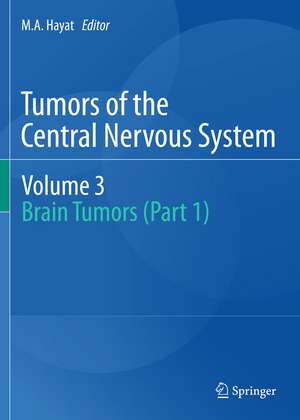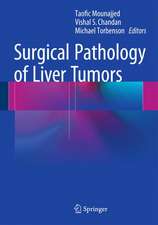Tumors of the Central Nervous system, Volume 3: Brain Tumors (Part 1): Tumors of the Central Nervous System, cartea 3
Editat de M.A. Hayaten Limba Engleză Paperback – 15 iul 2013
| Toate formatele și edițiile | Preț | Express |
|---|---|---|
| Paperback (1) | 1325.05 lei 39-44 zile | |
| SPRINGER NETHERLANDS – 15 iul 2013 | 1325.05 lei 39-44 zile | |
| Hardback (1) | 1338.46 lei 39-44 zile | |
| SPRINGER NETHERLANDS – 27 mai 2011 | 1338.46 lei 39-44 zile |
Preț: 1325.05 lei
Preț vechi: 1394.79 lei
-5% Nou
Puncte Express: 1988
Preț estimativ în valută:
253.56€ • 263.02$ • 211.43£
253.56€ • 263.02$ • 211.43£
Carte tipărită la comandă
Livrare economică 24-29 martie
Preluare comenzi: 021 569.72.76
Specificații
ISBN-13: 9789400736320
ISBN-10: 9400736320
Pagini: 404
Ilustrații: XXII, 382 p.
Dimensiuni: 193 x 260 x 21 mm
Greutate: 0.82 kg
Ediția:2011
Editura: SPRINGER NETHERLANDS
Colecția Springer
Seria Tumors of the Central Nervous System
Locul publicării:Dordrecht, Netherlands
ISBN-10: 9400736320
Pagini: 404
Ilustrații: XXII, 382 p.
Dimensiuni: 193 x 260 x 21 mm
Greutate: 0.82 kg
Ediția:2011
Editura: SPRINGER NETHERLANDS
Colecția Springer
Seria Tumors of the Central Nervous System
Locul publicării:Dordrecht, Netherlands
Public țintă
ResearchCuprins
Preface. Introduction.-1 General introduction.- 2 Brain tumor classification using magnetic resonance spectroscopy.- 3 Cellular immortality in brain tumors: an overview.-Part 1Tumor to tumor passage of malignancy.- 4 Tumor-to-tumor metastases: extracranial tumor metastasis to intracranial tumors.- 5 Brain metastases from breast cancer: treatment and prognosis.- 6 Brain metastasis in renal cell carcinoma patients.-7 Coexistance of inflammatory myofibroblastic tumors in the lung and brain.- 8 Breast cancer and renal cell cancer metastases to the brain.-9 Brain metastases from breast cancer: genetic profiling and neurosurgical therapy.-10 Central nervous system tumors in women who received capectiabine and lapatinib therapy for metastatic breast cancer.- Part II Biomarkers and diagnosis.-11 Functional role of the novel nrp/b tumor suppressor gene.-12 Brain tumors:diagnostic impact of pet using radiolabelled amino acids.-13 Malignant peripheral nerve sheath tumors: use of 18fdg-pet/ct.-14 Brain tumors: evaluation of perfusion using 3d-fse-pseudo-continous arterial spin labeling.-15 Cerebral cavernous malformations: advanced magnetic resonance imaging.-16 Nosologic imaging of brain tumors using mri and mrsi.-17 Brain tumor diagnosis using pet with angiogenic vessel-targeting liposomes.-18 Frozen section evaluation of central nervous system lesions.-19 Clinical role of micrornas in different brain tumors.-Part III Therapy.-20 Electrochemotherapy for primary and secondary brain tumors.-21 Brain tumors: convection-enhanced delivery of drugs (method).- 22 Brain metastases: clinical outcomes for stereotactic radiosurgery (method).-23 Noninvasive treatment for brain tumors:magnetic resonance guided focused ultrasound surgery.-24 Radioguided surgery of brain tumors.-25 Implications of mutant epidermal growth factor variant III in brain tumor development and novel targeted therapies.-26 Endoscopic port surgery for intraparenchymal brain tumors.-27Intracranial tumor surgery in the elderly patients.-28 Intracranial hemangiopericytoma: gamma knife surgery.-29 Stereotactic radiosurgery for cerebral metastasis of digestive tract tumors.-30 Malignant brain tumors: role of radioresponsive gene therapy.-Part IV Prognosis.-31 Brain tumors: quality of life.-32 Health related quality of life in patients with high-grage gliomas.-33 Epilepsy and brain tumors and antiepileptic drugs.-34 Familial caregivers of patients with brain cancer.-35 Pain management following craniotomy.-36 Air transportation of patients with brain tumors. Index.
Textul de pe ultima copertă
The classification of brain tumors is up-dated using magnetic resonance spectroscopy technology. The role of cellular immortality in brain tumors is reviewed. Tumor to tumor metastases are a common occurrence; for example, , brain metastasis from breast cancer, lung cancer, and renal cancer is discussed. Genetic profiling and treatment (including neurosurgery) of such brain cancers are explained. Breast cancer patients treated with certain drugs (e.g., capecitabine and lapatinib can develop CNS tumors. Role of brain tumor suppressor genes (e.g., NRP/B gene) is pointed out. Biomarkers used to diagnose brain malignancies are explained in detail. A number of imaging modalities used for diagnosing and assessing the effectiveness of treatments of brain tumors are presented. The imaging methods discussed include MRI, PET, CT, MRSi, and SPECT. Also, is discussed the impact of PET using radiolabeled amino acids on brain tumors.
Caracteristici
Frozen section evaluation of CNS lesions Methods of electrochemotherapy for primary and secondary brain tumors Stereotactic radiosurgery for brain metastasis and ultrasound surgery Epilepsy in brain tumor patients and treatment Pain management following craniotomy and quality of life of patients with brain tumors


























